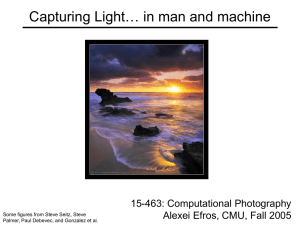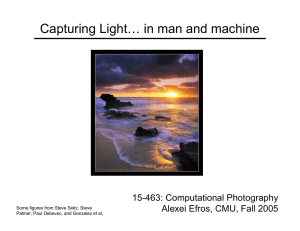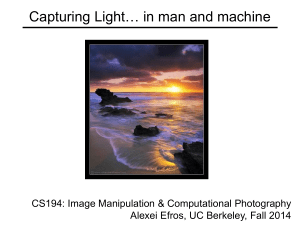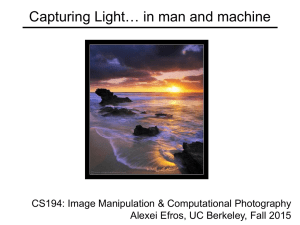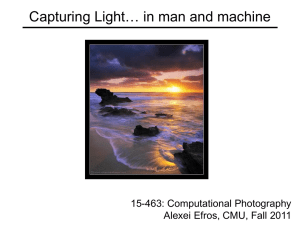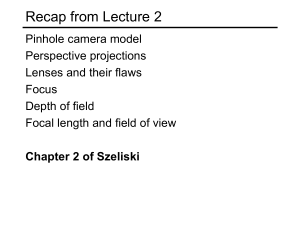ppt
advertisement
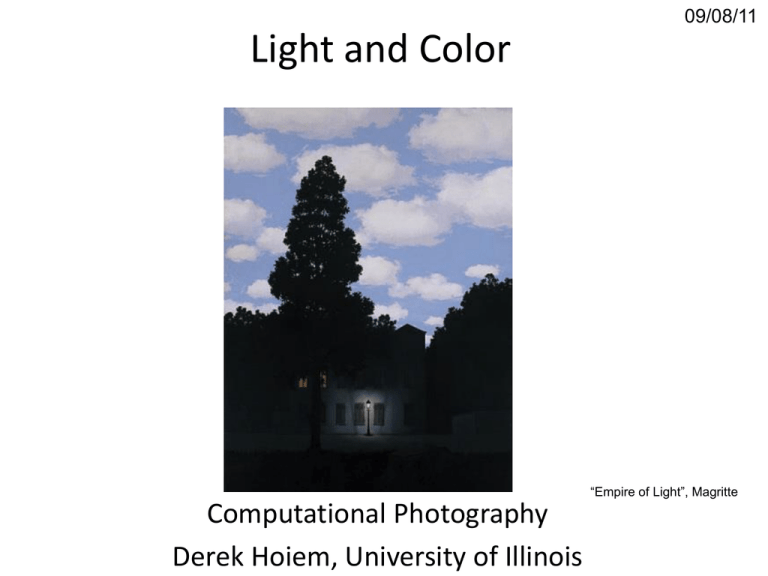
09/08/11 Light and Color “Empire of Light”, Magritte Computational Photography Derek Hoiem, University of Illinois Announcements • Project 1 due Mon, 11:59pm • I’m out of town Friday to Sunday (more difficult to answer e-mail) • Office hours Monday Today’s class • How is incoming light measured by the eye or camera? Incoming Light Lens Sensors/Retina Today’s class • How is incoming light measured by the eye or camera? • How is light reflected from a surface? Light source Reflected Light Incoming Light Lens Sensors/Retina Photo by nickwheeleroz, Flickr Slide: Forsyth The Eye The human eye is a camera! • Iris - colored annulus with radial muscles • Pupil - the hole (aperture) whose size is controlled by the iris • What’s the “film”? – photoreceptor cells (rods and cones) in the retina Slide by Steve Seitz Retina up-close Light Slide Credit: Efros Two types of light-sensitive receptors Cones cone-shaped less sensitive operate in high light color vision Rods rod-shaped highly sensitive operate at night gray-scale vision © Stephen E. Palmer, 2002 Slide Credit: Efros Rod / Cone sensitivity Slide Credit: Efros Distribution of Rods and Cones # Receptors/mm2 . Fovea 150,000 Rods Blind Spot Rods 100,000 50,000 0 Cones Cones 80 60 40 20 0 20 40 60 80 Visual Angle (degrees from fovea) Night Sky: why are there more stars off-center? © Stephen E. Palmer, 2002 Slide Credit: Efros Electromagnetic Spectrum Human Luminance Sensitivity Function Slide Credit: Efros http://www.yorku.ca/eye/photopik.htm Visible Light Why do we see light of these wavelengths? …because that’s where the Sun radiates EM energy © Stephen E. Palmer, 2002 The Physics of Light Any patch of light can be completely described physically by its spectrum: the number of photons (per time unit) at each wavelength 400 - 700 nm. # Photons (per ms.) 400 500 600 700 Wavelength (nm.) © Stephen E. Palmer, 2002 The Physics of Light Some examples of the spectra of light sources . B. Gallium Phosphide Crystal # Photons # Photons A. Ruby Laser 400 500 600 700 400 500 Wavelength (nm.) 700 Wavelength (nm.) D. Normal Daylight # Photons C. Tungsten Lightbulb # Photons 600 400 500 600 700 400 500 600 700 © Stephen E. Palmer, 2002 The Physics of Light % Photons Reflected Some examples of the reflectance spectra of surfaces Red 400 Yellow 700 400 Blue 700 400 Wavelength (nm) Purple 700 400 700 © Stephen E. Palmer, 2002 More Spectra metamers Physiology of Color Vision Three kinds of cones: 440 RELATIVE ABSORBANCE (%) . 530 560 nm. 100 S M L 50 400 450 500 550 600 650 WAVELENGTH (nm.) • Why are M and L cones so close? • Why are there 3? © Stephen E. Palmer, 2002 3 is better than 2… • “M” and “L” on the X-chromosome – Why men are more likely to be color blind (see what it’s like: http://www.vischeck.com/vischeck/vischeckURL.php) • “L” has high variation, so some women are tetrachromatic • Some animals have 1 (night animals), 2 (e.g., dogs), 4 (fish, birds), 5 (pigeons, some reptiles/amphibians), or even 12 (mantis shrimp) http://en.wikipedia.org/wiki/Color_vision We don’t perceive a spectrum • We perceive – Hue: mean wavelength, color – Saturation: variance, vividness – Intensity: total amount of light • Same perceived color can be recreated with combinations of three primary colors (“trichromacy”) Trichromacy and CIE-XYZ Perceptual equivalents with RGB Perceptual equivalents with CIE-XYZ CIE-XYZ RGB portion is in triangle Color Sensing: Bayer Grid Estimate RGB at each cell from neighboring values http://en.wikipedia.org/wiki/Bayer_filter Slide by Steve Seitz Alternative to Bayer: RGB+W Kodak 2007 How is light reflected from a surface? Depends on • Illumination properties: wavelength, orientation, intensity • Surface properties: material, surface orientation, roughness, etc. light source λ ? Lambertian surface • Some light is absorbed (function of albedo) • Remaining light is reflected equally in all directions (diffuse reflection) • Examples: soft cloth, concrete, matte paints light source absorption λ light source diffuse reflection λ Diffuse reflection Intensity does depend on illumination angle because less light comes in at oblique angles. 𝜌 = albedo 𝑺 = directional source 𝑵 = surface normal I = image intensity 𝐼 𝑥 = 𝜌 𝑥 𝑺 ⋅ 𝑵(𝑥) Slide: Forsyth 1 2 Diffuse reflection Perceived intensity does not depend on viewer angle. – Amount of reflected light proportional to cos(theta) – Visible solid angle also proportional to cos(theta) http://en.wikipedia.org/wiki/Lambert%27s_cosine_law Specular Reflection • Reflected direction depends on light orientation and surface normal • E.g., mirrors are fully specular Flickr, by suzysputnik light source λ specular reflection Θ Θ Flickr, by piratejohnny Many surfaces have both specular and diffuse components • Specularity = spot where specular reflection dominates (typically reflects light source) Photo: northcountryhardwoodfloors.com BRDF: Bidirectional Reflectance Distribution Function • Model of local reflection that tells how bright a surface appears when viewed from one direction when light falls on it from another surface normal ( i ,i , e ,e ; ) L e ( e , e ) L e ( e , e ) E i ( i , i ) L i ( i , i ) cos i d Slide credit: S. Savarese More complicated effects transparency light source light source refraction λ λ light source light source phosphorescence fluorescence λ1 λ2 t=1 t>1 light source light source subsurface scattering interreflection λ λ Inter-reflection is a major source of light Inter-reflection affects the apparent color of objects From Koenderink slides on image texture and the flow of light The color of objects • Colored light arriving at the camera involves two effects – The color of the light source (illumination + inter-reflections) – The color of the surface Slide: Forsyth Color constancy • Interpret surface in terms of albedo or “true color”, rather than observed intensity – Humans are good at it – Computers are not nearly as good Color illusions Color illusions http://www.echalk.co.uk/amusements/OpticalIllusions/colourPerception/colourPerception.html Shadows cast by a point source • A point that can’t see the source is in shadow • For point sources, the geometry is simple Slide: Forsyth Area sources • Examples: diffuser boxes, white walls • The energy received at a point due to an area source is obtained by adding up the contribution of small elements over the whole source Slide: Forsyth Area Source Shadows Slide: Forsyth Shading and shadows are major cues to shape and position From Koenderink slides on image texture and the flow of light Slide: Forsyth Recap 6 3 5 4 2 1 1. Why is (2) brighter than (1)? Each points to the asphault. 2. Why is (4) darker than (3)? 4 points to the marking. 3. Why is (5) brighter than (3)? Each points to the side of the wooden block. 4. Why isn’t (6) black, given that there is no direct path from it to the sun? Things to remember . – Humans (and RGB cameras) have color sensors sensitive to three ranges • Observed light depends on: illumination intensities, surface orientation, material (albedo, specular component, diffuse component), etc. • Every object is an indirect light source for every other • Shading and shadows are informative about shape and position RELATIVE ABSORBANCE (%) • Light has a spectrum of wavelengths 440 530 560 nm. 100 S M L 50 400 450 500 550 WAVELENGTH (nm.) 600 650 Take-home questions 09/08/11 1. Possible factors: albedo, shadows, texture, specularities, curvature, lighting direction
